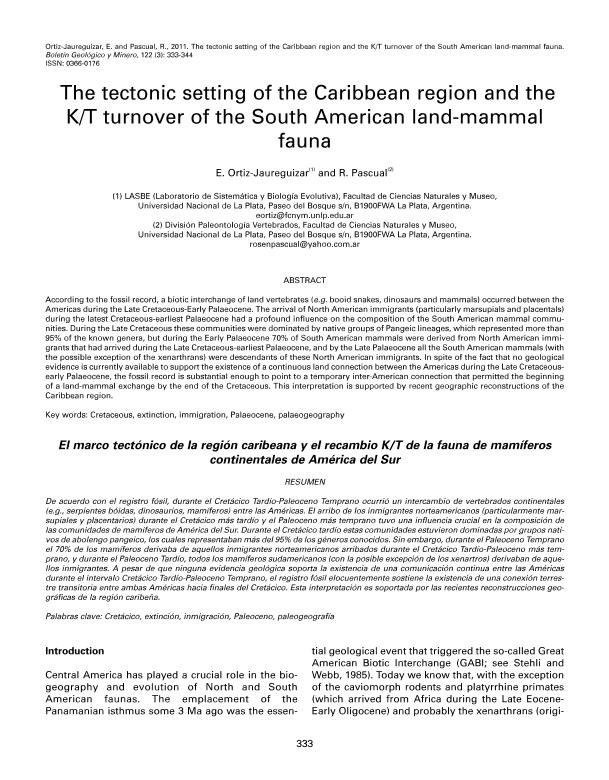Mostrar el registro sencillo del ítem
dc.contributor.author
Ortiz Jaureguizar, Edgardo

dc.contributor.author
Pascual, Rosendo

dc.date.available
2020-02-20T19:48:11Z
dc.date.issued
2011-07
dc.identifier.citation
Ortiz Jaureguizar, Edgardo; Pascual, Rosendo; The tectonic setting of the Caribbean region and the K/T turnover of the South American land-mammal fauna; Instituto Geológico y Minero de España; Boletín Geológico y Minero; 122; 3; 7-2011; 333-344
dc.identifier.issn
0366-0176
dc.identifier.uri
http://hdl.handle.net/11336/98171
dc.description.abstract
De acuerdo con el registro fósil, durante el Cretácico Tardío-Paleoceno Temprano ocurrió un intercambio de vertebrados continentales(e.g., serpientes bóidas, dinosaurios, mamíferos) entre las Américas. El arribo de los inmigrantes norteamericanos (particularmente mar-supiales y placentarios) durante el Cretácico más tardío y el Paleoceno más temprano tuvo una influencia crucial en la composición delas comunidades de mamíferos de América del Sur. Durante el Cretácico tardío estas comunidades estuvieron dominadas por grupos nati-vos de abolengo pangeico, los cuales representaban más del 95% de los géneros conocidos. Sin embargo, durante el Paleoceno Tempranoel 70% de los mamíferos derivaba de aquellos inmigrantes norteamericanos arribados durante el Cretácico Tardío-Paleoceno más tem-prano, y durante el Paleoceno Tardío, todos los mamíferos sudamericanos (con la posible excepción de los xenartros) derivaban de aque-llos inmigrantes. A pesar de que ninguna evidencia geológica soporta la existencia de una comunicación continua entre las Américasdurante el intervalo Cretácico Tardío-Paleoceno Temprano, el registro fósil elocuentemente sostiene la existencia de una conexión terres-tre transitoria entre ambas Américas hacia finales del Cretácico. Esta interpretación es soportada por las recientes reconstrucciones geo-gráficas de la región caribeña.
dc.description.abstract
According to the fossil record, a biotic interchange of land vertebrates (e.g. booid snakes, dinosaurs and mammals) occurred between the Americas during the Late Cretaceous-Early Palaeocene. The arrival of North American immigrants (particularly marsupials and placentals) during the latest Cretaceous-earliest Palaeocene had a profound influence on the composition of the South American mammal communities. During the Late Cretaceous these communities were dominated by native groups of Pangeic lineages, which represented more than 95% of the known genera, but during the Early Palaeocene 70% of South American mammals were derived from North American immigrants that had arrived during the Late Cretaceous-earliest Palaeocene, and by the Late Palaeocene all the South American mammals (with the possible exception of the xenarthrans) were descendants of these North American immigrants. In spite of the fact that no geological evidence is currently available to support the existence of a continuous land connection between the Americas during the Late Cretaceous-early Palaeocene, the fossil record is substantial enough to point to a temporary inter-American connection that permitted the beginning of a land-mammal exchange by the end of the Cretaceous. This interpretation is supported by recent geographic reconstructions of the Caribbean region.
dc.format
application/pdf
dc.language.iso
eng
dc.publisher
Instituto Geológico y Minero de España
dc.rights
info:eu-repo/semantics/openAccess
dc.rights.uri
https://creativecommons.org/licenses/by-nc-sa/2.5/ar/
dc.subject
Cretácico
dc.subject
Extinción
dc.subject
Immigración
dc.subject
Palaeoceno
dc.subject
Palaeogeografía
dc.subject.classification
Geociencias multidisciplinaria

dc.subject.classification
Ciencias de la Tierra y relacionadas con el Medio Ambiente

dc.subject.classification
CIENCIAS NATURALES Y EXACTAS

dc.title
The tectonic setting of the Caribbean region and the K/T turnover of the South American land-mammal fauna
dc.title
El marco tectónico de la región caribeana y el recambio K/T de la fauna de mamíferos continentales de América del Sur
dc.type
info:eu-repo/semantics/article
dc.type
info:ar-repo/semantics/artículo
dc.type
info:eu-repo/semantics/publishedVersion
dc.date.updated
2020-01-15T20:05:18Z
dc.journal.volume
122
dc.journal.number
3
dc.journal.pagination
333-344
dc.journal.pais
España

dc.journal.ciudad
Madrid
dc.description.fil
Fil: Ortiz Jaureguizar, Edgardo. Universidad Nacional de La Plata. Facultad de Ciencias Naturales y Museo. Laboratorio de Sistemática y Biología Evolutiva; Argentina. Consejo Nacional de Investigaciones Científicas y Técnicas. Centro Científico Tecnológico Conicet - La Plata; Argentina
dc.description.fil
Fil: Pascual, Rosendo. Universidad Nacional de La Plata. Facultad de Ciencias Naturales y Museo. División Paleontología Vertebrados; Argentina. Consejo Nacional de Investigaciones Científicas y Técnicas. Centro Científico Tecnológico Conicet - La Plata; Argentina
dc.journal.title
Boletín Geológico y Minero

dc.relation.alternativeid
info:eu-repo/semantics/altIdentifier/url/http://www.igme.es/Boletin/2011/122_3.htm
Archivos asociados
